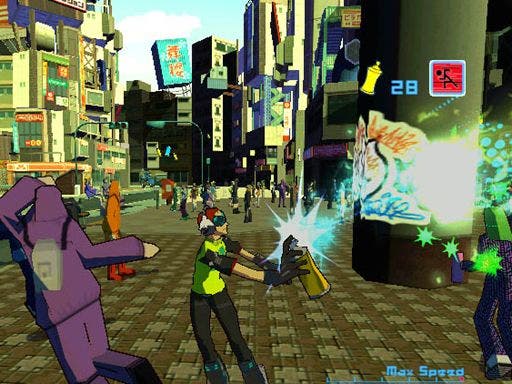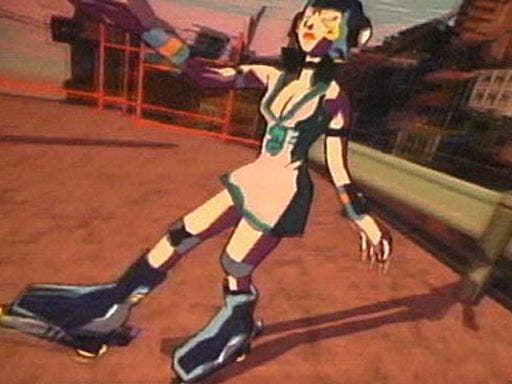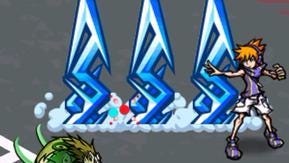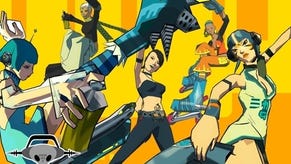Jet Set Radio Future
Review - JSR grinds its way back into our hearts, but Smilebit's Xbox debut is far from perfect

Back to the Future
Having invented cel-shading, it seems a mite unfair that Sega's Jet Set Radio didn't capitalise on the technique's popularity with roaring sales. Poor performance on the Dreamcast hardware and what I like to think of as the world's first vertical learning curve meant many players got sick of the game before they really got their fill. However, hoping to avoid that situation the second time around, developer Smilebit has dumbed down the long overdue successor to an almost infantile level, and we're still not sure we prefer the new approach. Like the previous game, Jet Set Radio Future gives you control of one of several skater teens, whose sole objective in the game is to cause trouble. They hang out at "The Garage", although unlike the first game this is now a rather enormous skate park with routes to all the game's major levels and lots of things to grind. At the centre of the skate park you can chat to a desperately annoying robot who saves your gave and gives you training objectives to complete, as well as acting as a doorway to the options menu and customizable graffiti. Missions begin with erstwhile DJ Professor K and his pirate Jet Set Radio station broadcasts. These usually consist of the mad professor bopping to beats and laying down your mission objectives, whether it's to (literally) paint the town red or knock down some Rokkaku bad guys. Unfortunately these short scenes are nowhere near as punchy as their counterparts from the original game, and they are completely unskippable. Thanks chaps. Beyond each unfathomable cutscene lies a sprawling level which is effectively split into a number of large areas which can be linked as you tick goals off on the objective list. As in the Dreamcast original you collect paint cans and use them to graffiti anything with a marker on it, but spraying graffiti no longer requires awkward analogue stick combos. This removes one of the toughest elements of the game, and manual tricks such as those witnessed in Tony Hawk allow you to skate slowly past marked areas spraying the whole thing in one go.

Bump and Grind
The streamlining continues elsewhere, and there's even further nods toward Neversoft's interminable skating franchise. The time limit for each level is gone, and the cop battles are no longer an ongoing distraction, now consisting of fenced off areas where you can bowl troopers over and spray them as they lie dazed on the ground. The joy of JSR was the way it gave you a lot of objectives and obstacles to overcome and gradually revealed the layout of the level as you completed them. The same is true of Future, but the challenge has been sapped, replaced by a series of connected "wow" moments punctuated by annoying cutscenes. Once again you have to recruit people for your skater gang the GG's by matching their skills on the street. This is often a case of grinding large areas of the level without putting a foot down, and thanks to the simplistic control system (no Tony Hawk style button to initiate a grind here - hit a rail and you're off without a hope of spilling) you're in a position to follow their lead without any difficulty. Sometimes the little nuts want a race to the finish, and that's a piece of cake too. Find a rooftop path which, once again, has been made drastically easier with the advent of grinding up telegraph poles, and you can't really lose. One further objective is to collect Graffiti Souls. Now, these souls are radio-shaped translucent white icons hidden in impossibly obvious places along the various paths you take. The game is quite generous, displaying the location of the souls after a while for confused players. In fact, presentation is generally of a high standard. The menus and speech bubbles are nicely drawn and in-keeping with the game's "funky" dynamic, although a plain old "cancel-the-hell-out-of-all-menus" button would have gone down a treat. As it is you can save your gave quite easily and there are mid-level save points too, which reveal themselves once you've sprayed the relevant area.

Night Rider
The most challenging aspect of the previous game was chasing down rival skater gangs, and this tug-o-war over territory endures. Poison Jam return, along with the Love Shockers, the Immortals, Zero Beat and others. There's a degree more storyline than JSR sported, but it's all very tongue-in-cheek. Taking out your competition is no longer an epic struggle, either. Having zipped through all of the game's main levels without even having to glance at the training area, I overran Gouji, the final boss, as though he were a first episode nasty. Compare some of the tasks in JSRF to those in Tony Hawk's seminal skater series and you begin to see why Smilebit want to make the distinction between the two so very significant. Or do they? Much to my chagrin, apparently they don't. Players are now encouraged (by way of bonus objectives) to amass points and tricks. Tricks are simple things like doing a 180 on a grind and hitting buttons during a jump, and obviously tricks amount to point before long. The difficulty here is that unlike Tony Hawk, the game won't throw you to the ground if you fail to keep the cursor in the right place, so if you find a loop of grinds (as with the 99th Street level), you can just keep going round and round forever. It's pretty pointless, and feels like a cheap gimmick to make the game "more accessible". Ultimately that's the impression this Xbox version of Jet Set leaves you with. It's a stunningly easy game, thanks in no small part to the simplistic control scheme (with jump, trick and spray buttons about as complex as it gets) and the consistently forgiving design. And although it seems like an obvious idea, there is no "hard" level or veteran's mode. If you fought your way through JSR, as I did, this is a slap in the face.

Small Victory
Technically though, JSRF managed to impress me quite a bit. The cel-shaded visuals, for instance, are the nicest application of the effect I've ever witnessed, crushing rival efforts and knock-offs like the cheap cash-in products they are. Smilebit hasn't confined itself to a cartoon world, either, embellishing the funky white dust clouds and spark-spitting grinds with all sorts of particle effects and a boost effect that sees the colours bleed into one another to create the perfect illusion of speed. Apart from that, the character design has been tweaked to the nth degree and virtually everybody walking or skating around the game is minutely detailed. This is a 3D cartoon tour de force - developers currently working with the cel-shading technique would do well to pay attention. But just as they give themselves a break, the developers plunge themselves back into the quagmire from whence they came. I am, frankly, completely flabbergasted by the degree of slowdown present in Jet Set Radio Future, not so much because it's a game beyond the Xbox, and not so much because it's still present months after we complained about it at Xperience, but because it doesn't need to be there. If Smilebit hadn't been so darned overambitious with the design this thing would be as smooth as Teflon coated shit off a shovel, but apparently it didn't occur to them to do this when they were mapping out important areas like the Garage, which slows to a crawl if you go near the central island, nor the game's most iconic setting, the Shibuya Terminal used in the first game. Even the press briefings and the damn introductory movie are afflicted. Heaven help me. On the audio front, there are some 30 tunes of mixed interest. Some of them I enjoyed, like tone-deaf oddity Birthday Cake, which just sort of worked for me, but others I could barely endure. On the whole, with so many tunes you're bound to find a few you like, and you'll just have to put up with the rest. Sadly there's no jukebox mode that I could find, but you can set your Garage background music to a specific tune.
Conclusion
As you may have guessed, I'm disappointed with Jet Set Radio Future. There's a great game in here, but Smilebit has once again failed to strike a proper balance between technology and gameplay. It's agonizing, as a fan, to watch them fluff it up for the second time. Terrific graphics and diverse sounds have been woven together to unrivalled effect, but the slowdown, complete lack of any discernible challenge from start to stop (it took me about 12 hours to finish) and lacklustre padding leave me disenchanted on the whole. If you really sucked at the last one, you'll find a reasonable amount of gameplay and a welcome adjustment on the difficulty side of things, but please, don't buy the console to play this. And if you already bought the console, give it a rental to make your mind up.
Tom "Mugwum" Bramwell
-
Jet Set Radio Future screenshots




